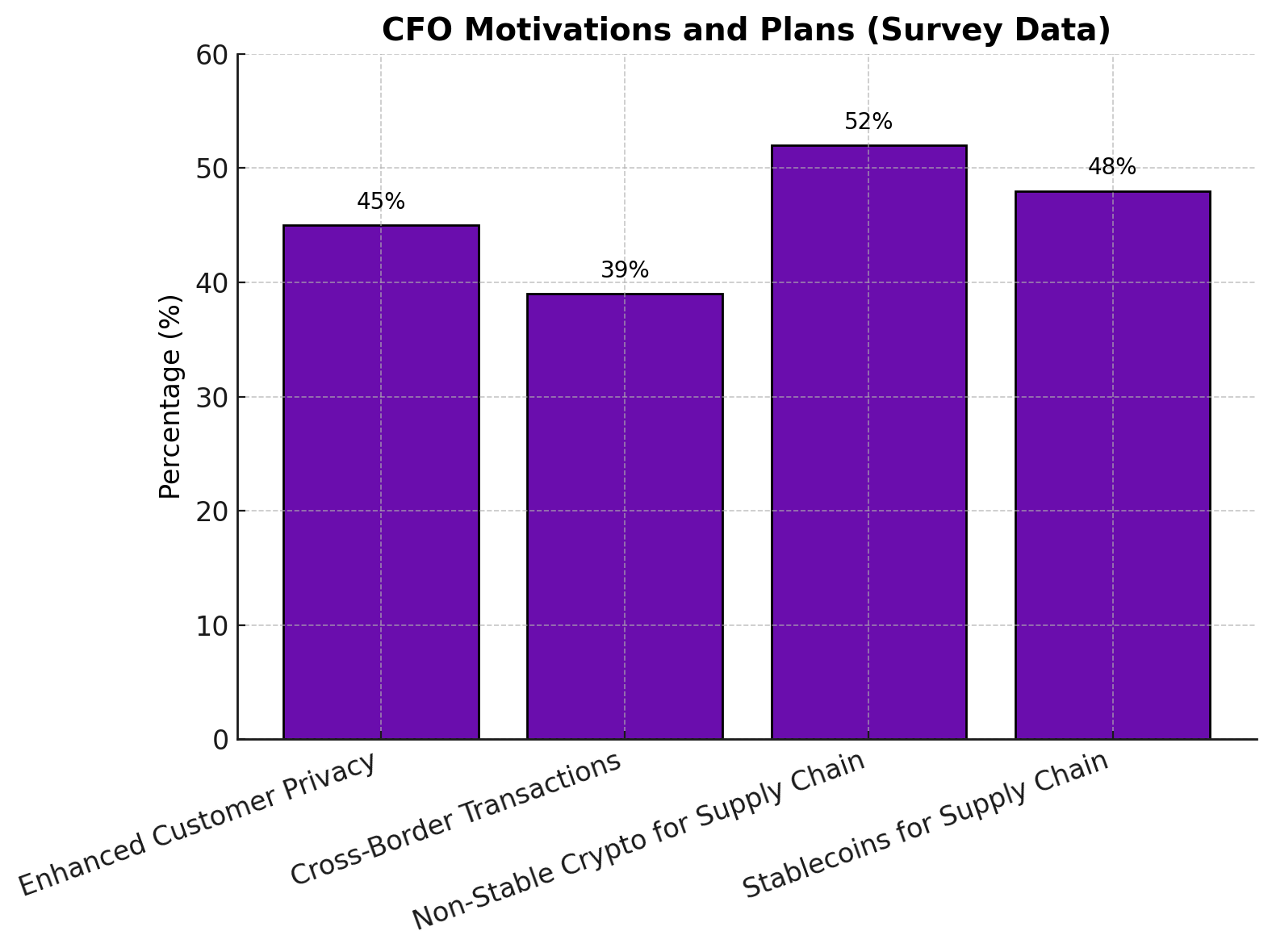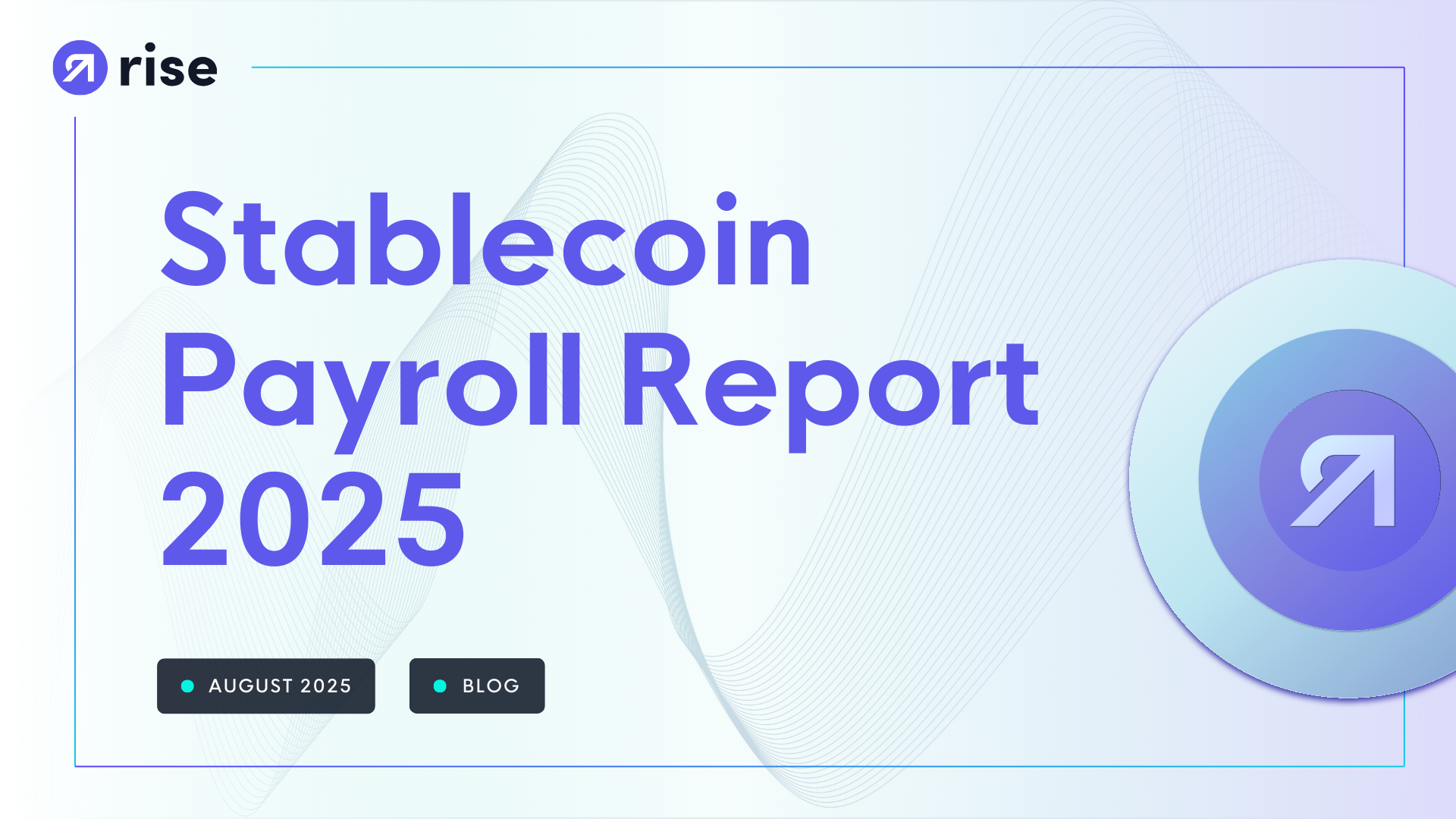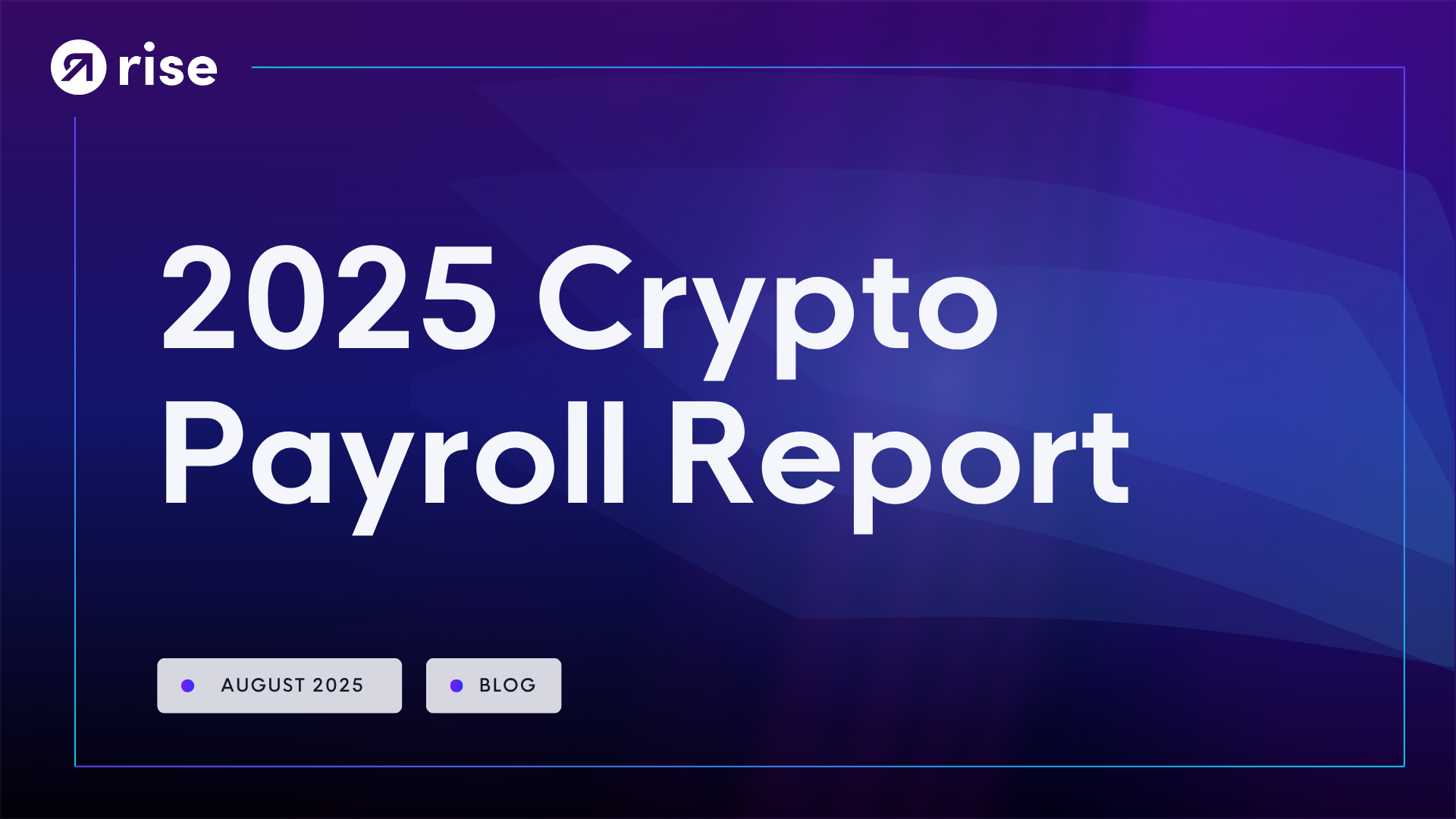Stablecoin payroll adoption has reached a tipping point in 2025, with one in four companies worldwide now paying employees in cryptocurrency. The transformation has been remarkably swift. Individual crypto payroll adoption tripled between 2023 and 2024, jumping from just 3% to 9.6% before most institutions even caught on.
What's driving this shift? For the cross-border payments industry, 2025 is clearly the year of stablecoins.
We're witnessing companies reduce their international payroll costs by an astonishing 95%, dropping from 6%+ with traditional banking to under $5 flat fees per transaction. Additionally, stablecoins facilitated over $28 trillion in transactions last year, outpacing both Visa and Mastercard combined.
In this comprehensive stablecoin payroll report, we'll examine data from more than 10,000 companies to reveal why USDC and USDT collectively account for over 90% of crypto salaries, how stablecoin payroll is reshaping global payment infrastructures, and what these trends mean for businesses still using traditional banking.
Whether you're considering the switch to stablecoin payroll or simply curious about the future of digital payments, this analysis provides essential insights into one of 2025's most significant financial shifts.
Key Takeaways
• Stablecoin adoption tripled from 3% to 9.6% in just one year, with 25% of companies now using crypto payroll and 75% of Gen Z workers preferring digital currency compensation.
• Companies slash payroll costs by up to 98%, reducing international payment fees from 6%+ with traditional banking to under $5 flat fees per stablecoin transaction.
• USDC dominates with 63% market share in payroll despite USDT's larger trading volume, driven by regulatory compliance and institutional trust that major payroll platforms require.
• Settlement times drop from 2-5 business days to minutes, enabling 24/7 global payments that eliminate banking delays and improve team morale across time zones.
• Regional adoption varies by economic need: Latin America uses stablecoins for inflation protection, Africa fills banking gaps, Southeast Asia gains cross-border efficiency, and Europe follows MiCA compliance.
Global Crypto Payroll Adoption: What the Data Shows
The numbers paint a clear picture: global crypto payroll has gone mainstream faster than many expected. Corporate financial leaders aren't just contemplating crypto adoption, they're actively planning for it.
Adoption growth from 2023 to 2025
Business adoption of cryptocurrency for payroll has surged by 66.7%, climbing from 15% in 2023 to 25% in 2025.
This growth isn't limited to crypto-native organizations.
According to Deloitte's Q2 2025 CFO Signals survey of 200 North American finance chiefs at billion-dollar companies, 23% expect their treasury departments to utilize crypto for investments or payments within the next two years.
Notably, larger corporations are moving even faster, among organizations with revenues exceeding $10 billion, nearly 40% of CFOs anticipate crypto integration in their finance operations within 24 months.
This acceleration reflects growing confidence in blockchain infrastructure for essential business functions.

Key findings from 10,000+ companies
The stablecoin payroll report 2025 reveals compelling insights about corporate crypto adoption:
- 45% of surveyed CFOs cited enhanced customer privacy protection as their primary motivation
- 39% pointed to improved cross-border transaction capabilities
- 52% anticipate using non-stable cryptocurrency for supply chain tracking
- 48% plan to implement stablecoins for the same purpose
Furthermore, conversations about cryptocurrency have reached boardroom level, with 37% of CFOs reporting discussions with their boards about integrating crypto into operations. Meanwhile, 41% have consulted their chief information officers, and 34% have approached their banks or lenders about cryptocurrency strategies.
Rise of stablecoin salaries among individuals
The shift toward stablecoin payroll began organically with employees rather than through top-down implementation.
According to Pantera Capital's comprehensive survey of 1,600 crypto professionals across 77 countries, individual adoption tripled from just 3% in 2023 to 9.6% by the end of 2024.
USDC leads this revolution with a commanding 63% market share of crypto salaries, while USDT accounts for 28.6%. Together, these stablecoins represent over 90% of all crypto payroll transactions, establishing them as the undisputed standards for digital compensation.
Generational differences are pronounced in this transition.
Approximately 75% of Gen Z workers now prefer receiving stablecoins as part of their compensation, drawn by benefits including:
- Instant global payments without banking delays
- Protection from local currency inflation (especially in emerging markets)
- Access to DeFi yield opportunities
- Alignment with digital-first financial habits
Consequently, we're seeing freelancers embrace crypto compensation particularly quickly—over 25% now opt for partial crypto payments, especially in software development and design roles.
The stablecoin payroll landscape in 2025 demonstrates that what began as a niche practice has evolved into a mainstream financial strategy, driven by practical benefits rather than speculative interest.
Stablecoin Market Share: USDC vs USDT in 2025
In the battle of stablecoins, two giants dominate the landscape in 2025, yet their roles differ dramatically across use cases. The stablecoin market has expanded to approximately $250 billion in total capitalization, revealing a complex relationship between market size and practical utility.
USDC's 63% dominance explained
Despite having a smaller overall market capitalization, USDC commands 63% of the stablecoin payroll market compared to USDT's 28.6%. This dominance comes as a surprise to many analysts given USDT's larger footprint in the broader crypto ecosystem. USDC's success in payroll stems primarily from its regulatory-first approach and transparency practices.

Circle, USDC's issuer, positions the token as a fully regulated digital dollar, conducting monthly attestations that verify each token is backed 1:1 by U.S. dollars. This transparency creates confidence among corporate treasury departments that must meet strict compliance requirements. Moreover, USDC has gained significant traction among institutional investors, making it the preferred choice for businesses integrating crypto into their financial operations.
Why USDT lags despite higher trading volume
USDT maintains its position as the largest stablecoin by market capitalization with over $143 billion in circulation and dominates daily trading with approximately $50 billion in volume compared to USDC's $5 billion. However, this trading dominance hasn't translated to payroll adoption.
The disconnect exists for several reasons.
First, USDT has faced numerous regulatory challenges throughout its history, creating uncertainty for businesses considering long-term financial infrastructure.
Second, although USDT represents 71% of stablecoin value transferred in 2025, it serves different use cases - primarily as a trading pair and value storage mechanism rather than a payroll solution.
Currently, USDT is utilized more often outside the United States as a store of value, with higher adoption in Asia and Europe. This regional preference contrasts with North American companies' preference for USDC in institutional applications, including payroll.
Platform support and regulatory trust
Perhaps the most decisive factor behind USDC's payroll dominance is infrastructure support. Upon investigation, Pantera Capital discovered that none of the major payroll providers besides Rise offer USDT as a payment option.
This infrastructure gap has created a significant advantage for USDC, which is supported by:
- All major payroll platforms
- Enhanced regulatory compliance meeting Western standards
- Direct fiat on/off ramps through established banking relationships
Essentially, institutional adoption follows the path of least resistance. USDC's regulatory clarity, including compliance with the EU's Markets in Crypto Assets (MiCA) framework, makes it easier for financial departments to justify its use.
The regulatory landscape continues to evolve, with the U.S. GENIUS Act providing a legal framework for stablecoin use.
This development has bolstered USDC's position, as Circle has taken proactive steps to strengthen its regulatory standing by pursuing a federal trust bank.
Throughout 2025, USDC's market share has steadily increased, growing from 19.5% to 22% year-over-year, while USDT's share declined from 73% to 66% during the same period.
This shift indicates a broader trend toward compliance-focused stablecoins in the professional financial ecosystem.

Cost and Speed: Why Companies Are Switching to Stablecoin Payroll
The financial benefits of stablecoin payroll have become impossible to ignore in 2025. Companies transitioning to digital currency payments are reporting dramatic reductions in both transaction costs and processing times, creating a compelling case for finance teams worldwide.
Traditional banking fees vs crypto fees
Financial data from over 10,000 companies reveals stablecoins slash transaction fees to just 0.5–3% of payroll amounts, compared to the 6.35% global average for traditional remittances, representing up to 98% cost savings per payment.
This efficiency translates directly to bottom-line improvements, with businesses reporting stablecoin salary payments cut approximately 3-5% off total payroll costs.
First and foremost, these savings compound significantly for businesses with global workforces.
For a 50-person remote team alone, companies typically save $2,000-$5,000 monthly by eliminating traditional banking fees.
In fact, companies processing more than $1 million monthly in international transactions are 92% more likely to use stablecoins compared to other businesses.
Settlement time comparison
Beyond cost considerations, settlement speed represents another critical advantage driving stablecoin adoption.
Traditional international wire transfers utilizing the SWIFT network typically take 2-5 business days to reach recipients, with further delays common during weekends and holidays.
In contrast, stablecoin transfers settle within minutes regardless of time zone or banking hours. This near-instantaneous settlement eliminates the frustrating delays associated with traditional systems:
- ACH bank transfers: 1-3 business days
- International SWIFT wires: Often 5+ days with intermediary banks
- Stablecoin transfers: Seconds to minutes, 24/7/365
The elimination of these delays improves not just efficiency but also relationships with team members.
As one report notes, "This matters when you're managing morale and trust in 12+ time zones".

Impact on global contractor payments
The effects on contractor relationships have been especially pronounced.
Currently, over 40% of freelancers express interest in receiving partial cryptocurrency payments, driven by both speed and financial autonomy benefits.
For companies employing global talent, stablecoin payroll eliminates many longstanding pain points: banking system incompatibilities, currency exchange complications, and access barriers in underbanked regions.
This seamless approach to cross-border compensation has proven particularly valuable for businesses with distributed teams.
Furthermore, stablecoin infrastructure eliminates the need to establish multiple local entities for international hiring, saving thousands in legal, compliance, and operational overhead.
Companies can now execute large-scale payroll transactions simultaneously without traditional banking delays, ensuring all team members receive compensation at the same time regardless of location.
Interestingly, many businesses report that stablecoin adoption started as a cost-saving measure but expanded into a strategic advantage, enabling faster contractor onboarding, simplified global expansion, and enhanced payment transparency through blockchain verification.
Regional Trends: Where Stablecoin Payroll Is Growing Fastest
Stablecoin payroll adoption varies dramatically by region, with economic conditions and financial infrastructure shaping usage patterns across continents. Rise's data reveals distinct regional drivers pushing businesses toward digital dollar solutions in 2025.
Latin America: Inflation protection
Throughout Latin America, stablecoins serve primarily as economic shields against severe currency instability.
In Argentina, where inflation reached a staggering 124% in 2023, workers increasingly demand USDC and USDT payments to preserve purchasing power.
This trend extends beyond Argentina like Chile's average inflation rate of 4.4% (exceeding the central bank's 3% target) has driven tech professionals toward stablecoin compensation.
First and foremost, businesses in these regions have discovered stablecoin payroll reduces exposure to local currency volatility.
Bolivian companies, facing the country's highest inflation rate in three decades at 25%, now regularly compensate employees in dollar-pegged stablecoins. This practice has evolved from emergency measure to standard procedure as Latin American freelancers specifically request crypto payments.
Africa: Banking infrastructure gaps
Across Africa, stablecoins thrive by filling critical banking infrastructure gaps. Sub-Saharan Africa now processes 43% of its crypto transaction volume through stablecoins, with Nigeria leading as the continent's largest market ($22 billion in transactions between July 2023-June 2024).
Specifically, stablecoins represent 6.7% of Africa's GDP in 2024 which is proportionally among the highest globally despite smaller absolute volumes than North America or Asia.
The distribution between tokens shows USDT dominates with 57.3% of African stablecoin flows, while USDC represents 42.7%. Whenever traditional banking proves inaccessible, mobile-first crypto solutions fill the void.
Southeast Asia: Cross-border efficiency
Southeast Asia's stablecoin adoption centers on cross-border payment efficiency. Presently, over 43% of B2B cross-border payments in the region utilize stablecoins, driven by:
- 20%+ of residents in key markets now holding cryptocurrency
- Traditional remittance fees averaging 8.3% versus stablecoin transfer costs below 0.1%
- A vast freelance economy (77 million workers) requiring efficient payment rails
The Philippines, Vietnam, and Indonesia lead this transformation, primarily using stablecoins for practical financial operations rather than speculation. For remote teams scattered across Southeast Asian countries, stablecoin payroll eliminates waiting periods and excessive fees previously considered unavoidable.
Europe: MiCA compliance and adoption
Europe's stablecoin payroll growth follows a distinctly regulated path through the Markets in Crypto-Assets (MiCA) framework. This comprehensive regulation, which entered force in June 2023, allows licensed stablecoin issuers to operate across all 27 EU member states through passporting rights.
Remarkably, only 18% of European respondents cite regulation as a barrier to adoption, whereas 58% are already using or planning to integrate stablecoins into payment flows.
Compliant stablecoins like EUROe, EURC, Monerium EUR, and Anchored Euro provide the regulatory certainty European businesses require, driving adoption among more conservative financial institutions.
Top Platforms and Infrastructure: Why Rise Payroll Leads in 2025
Among crypto payroll solutions in 2025, Rise has emerged as the clear industry leader. The platform's dominance stems from strategic partnerships, cutting-edge technology, and proven reliability that together create an unmatched infrastructure for global payments.
Circle partnership and USDC integration

Rise's official partnership with Circle, USDC's issuer, positions the transparent stablecoin as the cornerstone of its hybrid payroll infrastructure.
This collaboration goes beyond mere integration, it establishes Rise as a key player in global USDC adoption. Indeed, the partnership enables businesses to automatically onboard, hire, and pay global teams using USDC for both payroll funding and withdrawals.
As of June 2025, over half of Rise's contractors choose to withdraw earnings in stablecoins like USDC.
To expand adoption, Rise is currently rolling out educational resources that simplify USDC usage and wallet security for finance teams.
Arbitrum-native architecture for low fees
Unlike competitors relying on expensive Layer 1 blockchains, Rise built its platform natively on Arbitrum, the most popular Layer 2 network. This technical decision delivers crucial advantages:
- Ultra-low transaction fees (typically under $0.50)
- Lightning-fast processing with confirmations in seconds
- Ethereum's security combined with Layer 2 efficiency
Processed $800M+ in payroll with 99.9% uptime
Rise has successfully processed over $800 million in total payroll volume, demonstrating both scale and reliability.
This extensive track record includes payments to both independent contractors and full-time employees across hundreds of companies worldwide.
The platform's on-chain architecture ensures every transaction has a transparent, auditable trail while eliminating intermediaries and reducing settlement delays from days to seconds.
This approach maintains 99.9% uptime, critical for mission-critical payroll operations.
Conclusion
Stablecoin payroll has clearly evolved from a niche technology to an essential business strategy in 2025.
The data from 10,000+ companies undoubtedly shows this shift isn't merely speculative but driven by tangible benefits such as cost reductions of up to 98%, near-instant settlements, and protection against local currency instability.
Book a demo to learn more about stablecoin payroll from Rise
FAQs
What are the main benefits of using stablecoins for payroll? Stablecoins offer significant cost savings, with fees reduced by up to 98% compared to traditional banking. They also provide near-instant settlements, protection against local currency instability, and improved efficiency for cross-border payments.
Which stablecoins are most commonly used for payroll? USDC and USDT collectively account for over 90% of crypto salary payments. USDC leads with a 63% market share, while USDT accounts for 28.6%. USDC's dominance is attributed to its stronger regulatory compliance and institutional support.
How does stablecoin payroll adoption vary by region? Adoption patterns differ globally. Latin American companies use stablecoins as inflation shields, African businesses overcome banking limitations, Southeast Asian firms focus on cross-border efficiency, and European adoption follows regulated pathways like MiCA.
What percentage of companies are now using crypto payroll? As of 2025, 25% of companies worldwide are now paying employees in cryptocurrency. This represents a significant increase from previous years, with adoption growing rapidly across various industries and regions.
How has Rise Payroll become a leader in stablecoin payroll solutions? Rise Payroll has processed over $700 million in payments with 99.9% uptime. Their success is attributed to their Arbitrum-native architecture, which offers low fees and fast processing, as well as their strategic partnership with Circle for USDC integration and regulatory compliance.



















